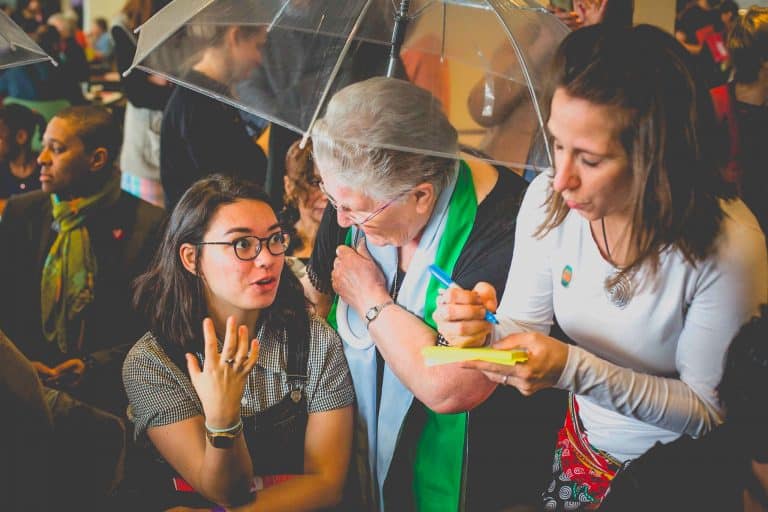
Image by Shonna/Flickr, Attribution.
Moving Beyond the Monosyllabic: Nine Pointers on How to Open a Richer Conversation with Your Family
As much as I miss the summer season, there’s a lot of good in returning to fall’s back to school routine. Mealtimes are regular, childcare’s easier to come by, and everyone’s back in the swing of things. But it’s easy to fall victim to some unhelpful patterns — in particular, communication patterns — as we try to connect in the midst of our crazy schedules. I’m thinking of a particularly formidable foe: the careless question and the monosyllabic response.
“How was school?”
“Fine.”
“What did you do after school?”
“Not much.”
As a dad and a practitioner of dialogue, I’ve gathered some pointers for myself that I hang onto for dear life when I hit a wall. Here’s what I try to remember to build richer, more connected relationships with my kids.
1. Choose a time and space that works — for all of you.
We think a lot at Public Conversations about being architects of conversation, whether with a conflicted community or at our own dinner table. It’s largely about being intentional about time and space. Any space can be good for communicating, but particularly in our day-to-day relationships, we all have some moments that are more suited than others.
Consider who is there, how long you have, and where everyone is in terms of hunger, tiredness, or crankiness. What works best for you? If your kids are eager to talk during the walk home from school, take advantage. If not, let them be. If, like me, the last thing you want to do when you walk in the door is to be drilled with a flurry of questions, ask for a moment to settle in and then find a time where you can be open. Whether it’s at dinner, reading books, playing cards or lying in bed at the end of the day, be intentional about what works for all of you.
2. Use questions that invite more than the monosyllabic.
“How was it?” doesn’t leave a lot of room for nuance. You’ll likely get “good, bad, sucks,” etc. We invite the monosyllabic by the questions that we ask. It isn’t fair to blame their lame response to my lame question.
Also, asking questions that imply a kind of judgment are limiting; a post-exam “did you do well?” invites a simple response — “good, bad, fine” — and one that reflects a set of proscribed values I’ve set up, as if the only experience of a test is a good or bad result.
How about “Ask me a question from your test today that you think might stump me — let’s see if I remember anything from school.” That might begin a conversation that goes beyond judgment and evaluation, and lays the foundation for connection and surprise.

3. Be an active partner, not an inquisitor.
Often the dynamic in place with parents and children is one where we’re the inquisitors and they’re on the spot, forced to respond within our framework. Rather than simply interrogate, what if we offered opportunities to respond in other ways beyond answering a question? What if we asked our kids to teach us something new, to introduce us to a comic book they’re into, or perhaps teach us a card trick or how to play a song? Resisting the temptation of the “I ask, you respond” dynamic can actually cultivate more organic exchange.
4. Ask for stories.
“Tell me a story about something that made you laugh today at school.” “Who was your favorite teacher today? What did they do?” As a dialogue practitioner, I’ve learned that while people might not like talking about a difficult situation, they love telling stories, particularly that illuminate their own lives, relationships and values. Stories invite reflection, revealing the untapped layers of meaning, ideas, and emotions that a factual question, however well meaning, just cannot. A story is an invitation for kids to tell us how they want to be known.

5. Tell our own stories.
Conversations with our friends aren’t one-sided; conversations with our kids shouldn’t be, either. We tell our friends stories about what happened to us during the day, what frustrated us or made us laugh, in addition to the nitty gritty of how we spent our time. Children learn how to have a conversation from the adults they’re closest to, so parents have a tremendous opportunity to model creativity, curiosity, and excitement. Our kids learn how to engage with others through engaging first with us. To solicit meaningful stories, we as parents must share our own.
6. Use a structure to ensure everyone is heard.
Sometimes the problem isn’t getting family members to talk, it’s getting them not to talk all at the same time. In dialogue, we’re big fans of the go-around, which allows everyone to listen and be heard without interruption or being derailed. These kinds of structures allow kids of all ages and personality types (and adults, too, for that matter) to express themselves without being run over by those who are older, quicker, or louder. What a gift we give to a child when we make space for them to be heard by others, especially when that is not their normal experience.

7. Actually listen.
Sometimes, it’s really hard not to ask out of obligation or impulse. We ask and then get back to thinking about dinner or problems at work. If we ask, we had better be prepared to listen fully. Kids pick up quick when we are feigning interest. And listening for red flags isn’t the best kind of listening either, at least not if we want relationships based on openness and authenticity. Kids will know better than to tell you something important when you’re listening for red flags and ready to point out their flaws. Asking questions is only half the equation; it’s critical to listen and respond with the same thoughtfulness you’re hoping from your kids.
8. Silence is more than not talking.
Don’t discount the kind of communication that can come with silence. Just sharing a walk or watching the stars can be hugely connecting. Sitting side-by-side reading a book can be a profound experience. Sometimes words actually get in the way of something much bigger.
9. Don’t just accentuate the positive and eliminate the negative.
While reflecting on high points or favorite moments is important, we’re missing a lot if we only ask what went well. We can talk about high points while embracing mistakes or disappointments, and exploring together what went wrong. Conversations that acknowledge both the peaks and the pitfalls normalize difficult feelings and setbacks. If we’re willing to dig deeper, they also often illuminate a much more complex emotional inner life within our kids than we may have assumed. That’s why at my house, we talk about our “rose and thorn” at the end of the day, and our “wish and our worry” for the day on the way to school.
These are the touchstones I return to when I am stuck in a rut with my kids. How do you engage your children in richer conversations? What are your tips and what questions do you use? Share and let’s make all our conversations a little more connected and meaningful.


Share your reflection